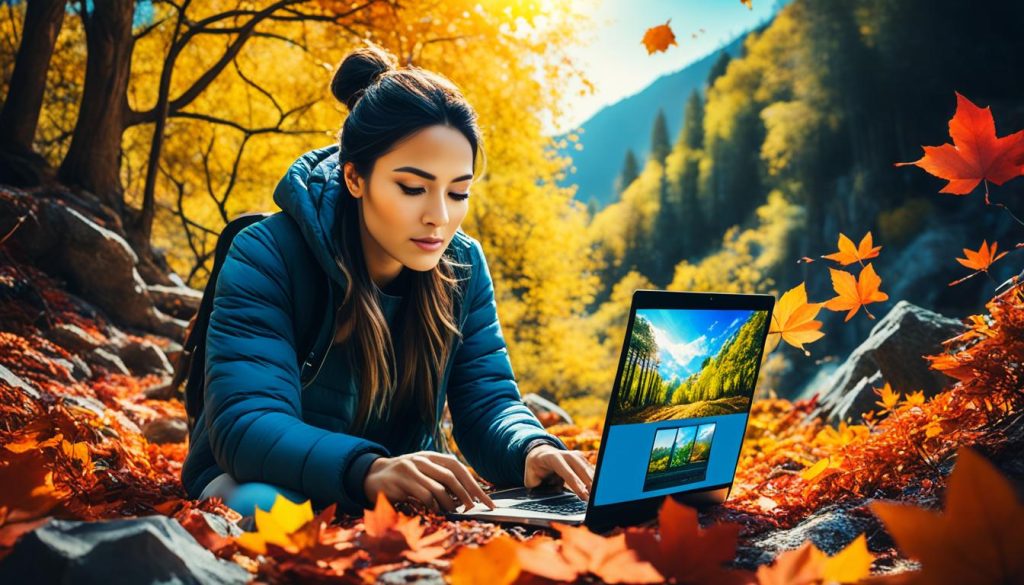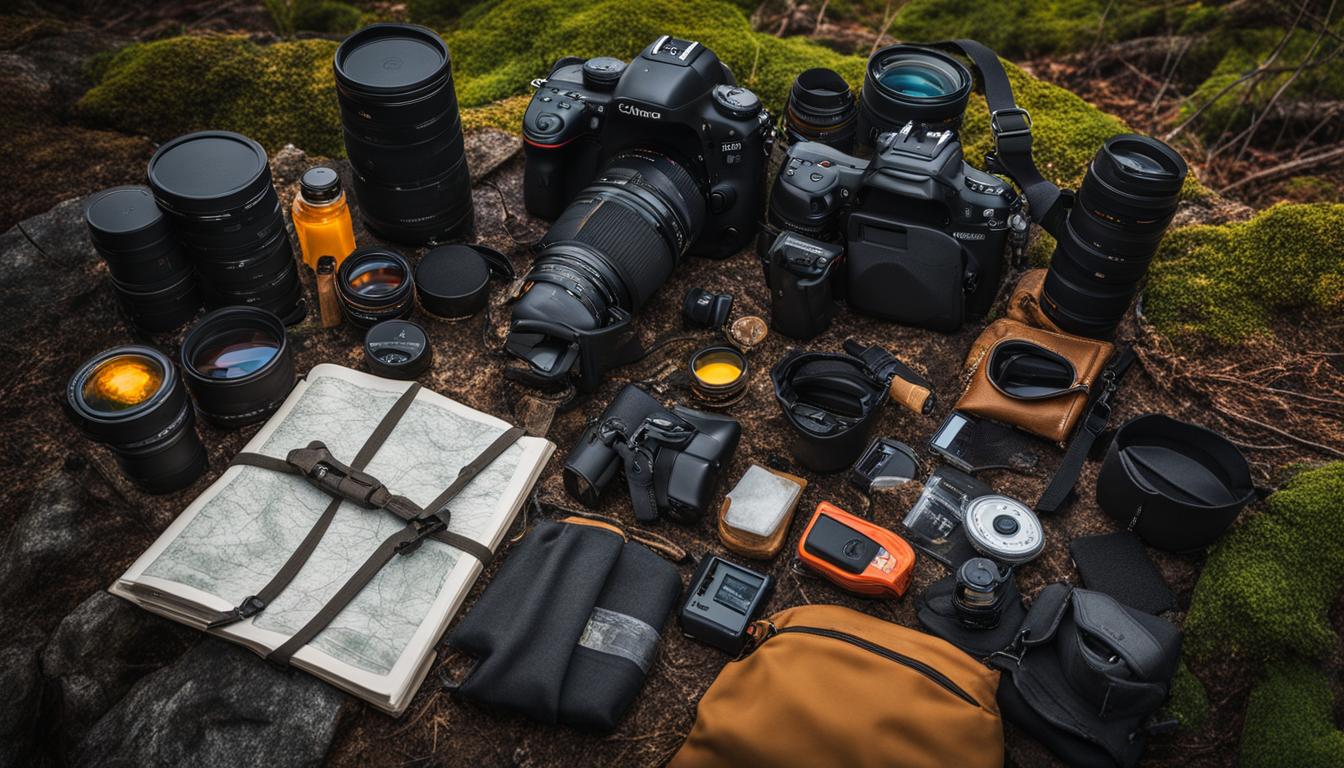If you love nature and photography, adventure photography is an opportunity to combine your two passions. However, setting out on your first photo journey can be overwhelming. What camera gear do you need? What about outdoor clothing and accessories? And how do you plan for the unexpected?
In this comprehensive guide, we will provide you with the ultimate adventure photography checklist to ensure you are well-prepared for your photo journey. Our guide covers everything from essential camera gear and outdoor clothing to planning, safety, shooting techniques, and post-processing. Whether you are hiking in the mountains, exploring the wilderness, or traveling to exotic locations, this checklist will help you capture every moment seamlessly.
Key Takeaways:
- Adventure photography requires preparation and planning to ensure a successful shoot.
- Essential camera gear includes a good camera body, lenses, filters, and accessories.
- Outdoor clothing and accessories are necessary for comfortable and safe photography in various weather conditions.
- Knowing potential risks and carrying a first aid kit are essential for safety during adventure photography.
- Mastering shooting techniques and compositions can help you capture stunning adventure photos.
Essential Camera Gear
Before setting forth on your adventure, it’s crucial to ensure that you have the right adventure photography gear. Equip yourself with the essentials, namely, the best camera body, lenses, tripod, filters, and additional accessories to enhance your shots.
Camera Body
Invest in a high-quality camera body that can handle various shooting conditions. A mirrorless or DSLR camera with weather-sealed and durable construction, fast autofocus, and high-resolution sensors will help you capture impeccable images.
Lenses
Along with the perfect camera body, it’s important to have the right lenses to capture different focal ranges. Invest in a versatile lens, such as a 24-70mm f/2.8, for capturing a variety of shots. A wide-angle lens, like the 16-35mm f/4, can be handy when shooting landscapes, while a telephoto lens, like the 70-200mm f/2.8, can help you capture amazing action shots.
Tripod
Don’t forget to bring a sturdy and reliable tripod to steady your camera during long exposures, low-light photography, and when capturing self-portraits. Choose a tripod that’s lightweight and easy to pack, yet durable and strong enough to withstand the elements.
Filters
Filters can significantly enhance your adventure photography by reducing glare, managing contrast, and saturating colors. A circular polarizer filter can help you eliminate reflections and enhance colors, while a neutral density filter is essential for controlling exposure in bright light conditions and for capturing long exposure shots.
Additional Accessories
Pack additional must-have camera equipment, such as spare batteries, memory cards, a camera bag, lens cleaning kit, rain covers, and a remote shutter release to ensure that you’re always prepared.
Outdoor Clothing and Accessories
When embarking on an adventure photography expedition, it is essential to dress appropriately and pack the necessary accessories to maximize your comfort and protect yourself from the elements.
Adventure photography clothing should be designed to keep you protected and comfortable in all weather conditions. Pack items such as weatherproof clothing, thermal layers, and sturdy footwear, as well as a hat, gloves, and sunglasses to shield yourself from the sun, wind, and cold.
Aside from clothing, outdoor gear for photographers includes items such as a backpack to carry your camera equipment, water bottle, and snacks, as well as additional accessories such as a headlamp, sunscreen, and insect repellent.
Remember, when packing, you want to focus on essentials that will keep you comfortable, prepared, and safe throughout your adventure.
Planning and Research
Adventure photography is all about capturing the perfect moment in a stunning location. To ensure you make the most of your shoot, it’s important to plan and research your trip. Start by researching potential locations that align with your vision and style. You can use online resources, such as Google Maps or social media hashtags, to find inspiring locations that fit your needs.
Once you’ve identified a location or several locations, it’s crucial to understand the weather and lighting conditions in the area. Check local weather forecasts and consider the best time of day for optimal lighting. Additionally, scouting the area and creating a shot list will help you maximize your time and opportunities during your shoot.
By taking the time to plan and research, you’ll be able to capture stunning adventure photos that exceed your expectations.
Safety and First Aid
Adventure photography can be an exhilarating experience, but it also involves risks and potential hazards. Ensuring your safety is paramount during expeditions. Always carry a first aid kit that can be quickly accessed in case of unforeseen emergencies, such as minor cuts and bruises or more severe injuries.
It’s also essential to understand potential risks and hazards associated with your photography locations. For instance, wild animals, steep cliffs, and extreme weather conditions can pose serious threats, so it’s crucial to be prepared and take the necessary precautions. Checking weather forecasts and being aware of current conditions can help you to avoid dangerous situations.
Emergency situations can occur, especially in remote locations, where help may not be readily available. Ensure that you are appropriately trained in basic first aid techniques, and have ample knowledge in handling emergency situations such as snake bites, heat exhaustion, or hypothermia.
Most importantly, prioritize your safety when planning your adventure photography journey. Take wise precautions and remain alert while photographing in natural areas. By following essential safety practices and first aid essentials, you can minimize risk and ensure a safe and enjoyable photography experience.
Shooting Techniques and Compositions
Capturing breathtaking adventure photos requires a combination of technical skill and artistic vision. To take your adventure photography to the next level, consider these adventure photography techniques and composition tips for outdoor photography.
Master Action Shots
Action shots can be challenging to capture, but they’re a great way to add excitement and energy to your adventure photography portfolio. To get dynamic shots, use a fast shutter speed and track your subject to keep it in focus. Additionally, consider shooting bursts of photos to increase your chances of getting the perfect shot.
Capture the Landscapes
One of the best things about adventure photography is getting to shoot in some of the most beautiful locations around the world. To capture breathtaking landscape shots, use wide-angle lenses to include as much scenery as possible in your frame. Also, consider framing your shot with foreground objects, such as rocks or trees, to add depth and interest to your photos.
Use Lighting to Your Advantage
Lighting is a crucial element in photography, and outdoor lighting can be especially tricky. During the golden hours (early morning and late afternoon), the light is softer and warmer, creating a beautiful glow in your photos. However, if you’re shooting during midday, when the light is harsher, try finding shaded areas to avoid harsh shadows and overexposure.
Compose Visually Pleasing Images
Composition is the art of arranging elements in your shot to create a visually pleasing image. Consider using the rule of thirds when composing your shots, placing your subject off-center to create a more interesting composition. Additionally, try experimenting with different angles and perspectives to add depth and variety to your adventure photos.
By mastering adventure photography techniques and following these composition tips for outdoor photography, you’ll be well on your way to capturing stunning and dynamic adventure photos that truly stand out. So, get out there and start exploring with your camera!
Post-Processing and Editing
After capturing breathtaking images on your adventure photography journey, it’s essential to post-process and edit them to bring out their full potential. The following are the essential steps for processing outdoor photos:
- Adjusting Exposure: Adjusting the brightness and contrast levels can help balance the exposure and highlight details in your image. Use the histogram tool in your post-processing software to correct underexposed or overexposed areas.
- Color Correction: Adjusting the colors on your image will give them a consistent and natural look. Always correct the temperature and color tint first, then proceed to the saturation and hues.
- Sharpness: Outdoor photos tend to be soft, and sharpening your images will give them a crisp and clear look. Avoid over-sharpening as it can cause unwanted haloing or artifacts in the image.
- Organize and backup: Keeping your files organized and backed up is crucial, especially when dealing with large volumes of data. Use a reliable storage system or cloud service to store and backup your files regularly.
Remember to keep your edits and adjustments in moderation, as overediting may render your photos unappealing.
Editing Tools
“Editing is where the magic happens, turning a simple image into a masterpiece”
Choosing the right editing tool for your outdoor photos can make a significant difference in the final result. The following are the most widely used post-processing software or applications by adventure photographers:
- Adobe Lightroom: A go-to choice for many adventure photographers, it offers a vast range of tools to enhance your images, including color correction, exposure adjustments, and cropping.
- Adobe Photoshop: This software offers tremendous editing capabilities, including retouching, special effects, and layering.
- GIMP: If you’re on a budget, GIMP is an open-source free alternative to Photoshop. It offers similar functionality, including layers, masks, and blending modes.
Whatever software you opt for, learning proper post-processing and editing techniques will significantly improve the outcome of your outdoor photos. Get creative and be adventurous!

Conclusion
That wraps up our ultimate adventure photography checklist guide! We hope this comprehensive guide has prepared you for your next photography adventure, whether you’re hiking in the mountains or exploring the great outdoors.
By following the checklist for essential camera gear and outdoor clothing and accessories, you’ll be well-equipped to capture stunning photos in any environment. Remember to thoroughly plan and research your trip, ensure your safety, and master shooting techniques and compositions to create visually stunning images.
And when you return from your adventure, don’t forget the essential steps of post-processing and editing to enhance your images. By following these guidelines, you’ll be able to capture every moment seamlessly and create memories that will last a lifetime.
So, what are you waiting for? Get out there and start capturing your next adventure!






